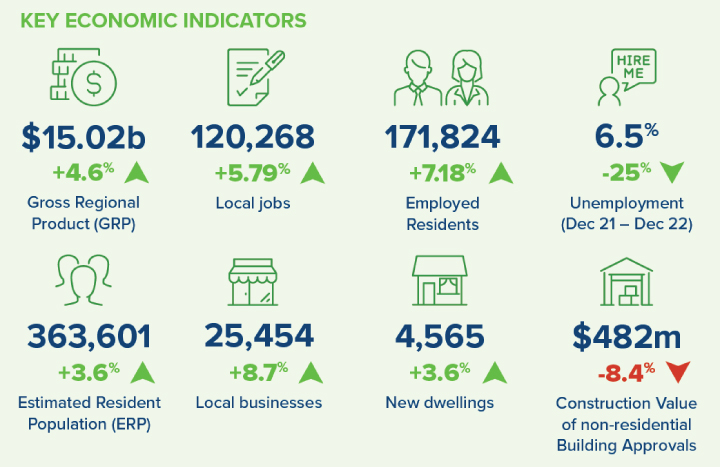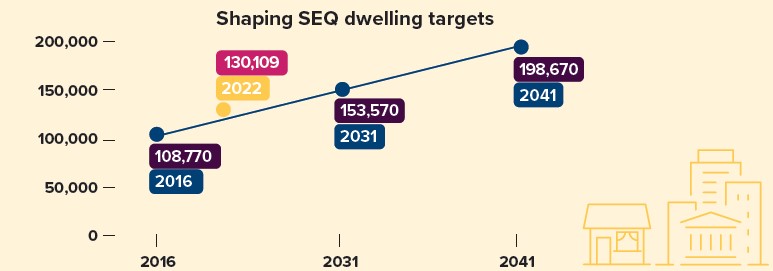Logan City Council collects key economic statistics and information to measure how the city is performing. This information has been compiled into the 2021/22 Economic Analysis Report. Most of the data is from the end June 2022 reporting period, but is noted if the data set contains data from different time periods. Links to relevant data sources are included where possible. View the summary pdf.
Key Economic Indicators

Gross Regional Product (GRP)
The City of Logan has continued its strong growth coming out of COVID-19 with 2-year average growth in GRP at 5.25%. GRP has increased 12.1% in the five years since June 2017 and is now over $15 billion.
Growth in Logan is being driven by construction, health care and social assistance, and administrative and support services industries.
|
Year
(ending 30 June) |
GRP
($m) |
%
change from previous year |
|
2022 |
15,023 |
+4.60 |
|
2021 |
14,362 |
+5.89 |
|
2020 |
13,564 |
-1.02 |
|
2019 |
13,703 |
+2.27 |
|
2018 |
13,398 |
+5.82 |
Industry
Construction continues to be the biggest industry in the city by economic output, generating $5.9 billion in 2021/22 – an increase of $791 million from 2020/21.
Top industries by output
- Construction – $5.90 billion (+$791 million from 2020/21)
- Manufacturing – $3.68 billion (-$61 million)
- Health Care and Social Assistance – $2.19 billion (+$180 million)
- Transport, Postal and Warehousing – $1.88 billion (+$100 million)
Five industries saw a reduction of output in the 12 months to June 2022:
- Manufacturing – $3.68 billion (-$61 million)
- Mining – $69.2 million (-$43 million)
- Financial and Insurance Services – $736 million (-$21 million)
- Information Media and Telecommunications – $369 million (-$12 million)
- Education and Training – $1.15 billion (-$5 million)
Manufacturing is the city’s biggest exporter with a value of $1.3 billion. Food Manufacturing, Primary Metal and Metal Product Manufacturing, Fabricated Metal Product Manufacturing, and Polymer Product and Rubber Product Manufacturing make up the majority of this industry.
Employment
The top employing industries as at June 2022
- Health Care and Social Assistance – 20,427 jobs (+2,462 from 2020/21)
- Construction – 20,191 jobs (+1,254)
- Retail Trade – 14,544 jobs (+844)
- Education and Training – 12,492 jobs (+784)
Local Jobs
There were 120,268 jobs located in the City of Logan in the year ending June 2022. This represents a 5.79% increase from 113,684 jobs at June 2021.
Logan has recorded strong local jobs growth of 8.6% from June 2017 to June 2022. Although jobs growth stalled between 2019 and 2021, there was a good recovery, with financial year 2021/22 having the largest growth in local jobs in the last 25 years and above the Queensland growth rate of 4.7%.
|
Year (ending 30 June) |
Local jobs |
% change from previous year |
|
2022 |
120,268 |
+5.79 |
|
2021 |
113,684 |
+2.20 |
|
2020 |
111,233 |
-1.37 |
|
2019 |
112,782 |
+1.80 |
|
2018 |
110,790 |
+5.15 |
The 2021 Census data showed that for the 102,853 local jobs in the city, 59% of those were occupied by Logan residents. The other 41% of workers live in other Council areas and commute into the city for work. Main residential locations include Brisbane (20.4%), Gold Coast (8.7%), Redland (4.2%) and Ipswich (3.6%).
Local workers
Of the 151,633 employed Logan residents in the 2021 Census data, 40% live and work in the City of Logan, 54.1% travel outside the city for work, and 5.9% have no fixed place of work. Brisbane was the main employment centre, with 57,120 (37.7%) Logan residents travelling to the Brisbane Council area for work.
Unemployment (Dec 2022 data)
The unemployment rate has been trending downwards since September 2021 and is 6.5% for the December 2022 quarter. It is at its lowest rate since September 2017.
|
|
Unemployment Rate % |
Change in % points |
|
Period: Quarter |
Dec 21 |
Mar 22 |
Jun 22 |
Sep 22 |
Dec 22 |
Dec 21 to Dec 22 |
|
Australia |
5.1 |
4.6 |
4.3 |
4.0 |
3.7 |
-1.4 |
|
Queensland |
5.5 |
4.9 |
4.5 |
4.2 |
3.9 |
-1.6 |
|
Brisbane |
5.0 |
4.3 |
3.8 |
3.4 |
3.2 |
-1.8 |
|
Gold Coast |
4.8 |
4.4 |
3.9 |
3.4 |
2.9 |
-1.9 |
|
Moreton Bay |
5.7 |
5.0 |
5.1 |
4.5 |
4.1 |
-1.6 |
|
Redland |
4.2 |
3.1 |
2.7 |
2.3 |
2.3 |
1.9 |
|
Ipswich |
7.8 |
6.7 |
6.3 |
6.4 |
6.4 |
-1.4 |
|
City of Logan |
8.7 |
7.7 |
7.1 |
6.8 |
6.5 |
-2.2 |
Areas with the lowest unemployment rate
- Shailer Park – 2.1%
- Cornubia – Carbrook – 2.2%
- Rochdale South – Priestdale – 3%
- Greenbank – 3%
- Daisy Hill – 3%
- Wolffedene – Bahrs Scrub – 3%
- Munruben – Park Ridge South – 3.1%
Areas with the highest unemployment rate
- Logan Central – 22.9%
- Kingston – 16%
- Loganlea – 11.7%
- Beenleigh – 11.5%
- Eagleby – 11%
Areas with most improved unemployment rate over the last 12 months
- Shailer Park (3.5% to 2.1%) -40%
- Mount Warren Park (7.8% to 5.1%) -35%
- Wolffedene – Bahrs Scrub (4.5% to 3%) -33%
- Hillcrest (6.2% to 4.2%) -32%
- Bethania – Waterford (8.5% to 5.8%) -32%
Local Businesses
There was a net increase of 2,031 local businesses from June 2021 to June 2022. The highest amount of new businesses were in the Construction, Transport, Postal and Warehousing, and Administrative and Support Services Industries.
Number of businesses by turnover
- Zero to less than $50k – 6,607
- $50k to less than $200k – 8,047
- $200k to less than $2m – 7,328
- $2m to less than $5m – 845
- $5m to less than $10m – 297
- $10m or more – 275
Population
The Estimated Resident Population of the City of Logan is 363,301 as at June 2022. This is a 3.53% increase since 2020/21 and makes Logan the second-fastest growing LGA in Queensland. The 5-year average growth is 2.6%.
Net migration to the city has been the highest from Brisbane (+3,793), followed by Gold Coast, Townsville and Blacktown (NSW). Net migration loses have been to Ipswich (-1,166), Sunshine Coast, Moreton Bay, Lockyer Valley and Fraser Coast.
Estimated population growth is highest in the following SA2 areas
- Chambers Flat – Logan Reserve – +18.9%
- Greenbank – North Maclean – +13.2%
- Wolffdene – Bahrs Scrub – +12.9%
- Yarrabilba – +12.2%
- Boronia Heights – Park Ridge – +11.7
Development Activity Highlights
- New non-residential development approvals continue to grow, with 272,797m² of new non-residential Gross Floor Area (GFA) space approved for 2021/2022 (excludes mixed use).
- The biggest increases in non-residential growth occurred in Low Impact Industry, with 37,172m² of new floor space (GFA) approved.
- Estimated value of new non-residential work of $482,350,355 (excludes mixed-use, demolitions, alterations and fit-outs).
- Over 4,500 new dwellings have been added to the city’s housing stock (130,109 as at June 2022). Of these additional dwellings, the most popular dwelling type was a stand-alone house, followed by a house with a secondary dwelling/auxiliary unit.
- Logan is on track to deliver our dwelling number targets that are set by the State Government’s SEQ Regional Plan. As at June 2022 the city has 130,109 dwellings moving towards 198,670 by 2041.
Note: New dwelling targets are currently being considered as part of an ShapingSEQ review, and are likely to change in the near future.

Top 5 suburbs for residential dwelling approvals were
- Logan Reserve – 811
- Park Ridge – 506
- Greenbank – 465
- Yarrabilba – 204
- Flagstone – 177
Census Comparison Data
To see changes to the City of Logan’s demographic data from the 2016 Census to the 2021 Census, see our fact sheet.

